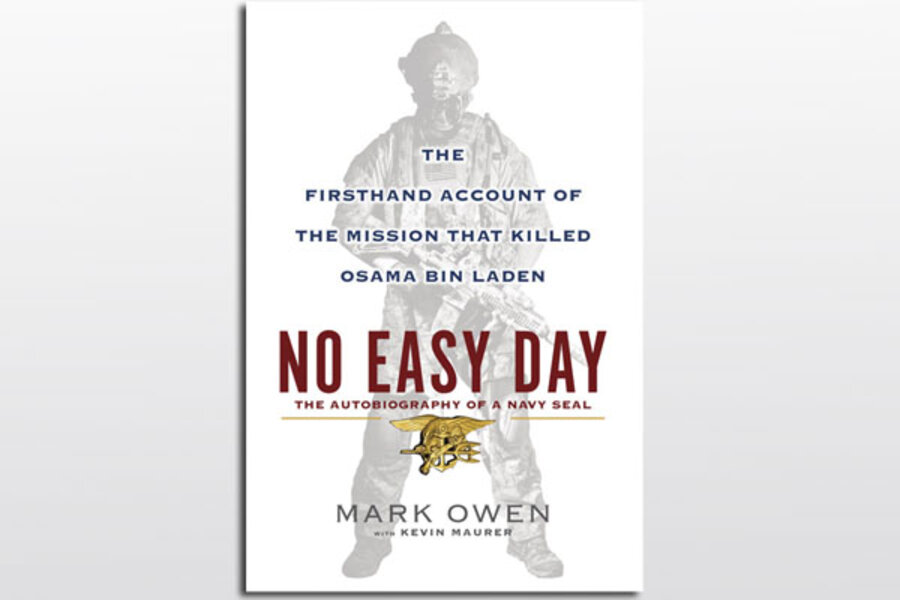How credible is the author of 'No Easy Day'?
Loading...
| Washington
Just how reliable is the Navy SEAL who has written the controversial, insider account of the US raid on Osama bin Laden’s compound?
Matt Bissonnette, who wrote “No Easy Day” under the pen name of Mark Owen, offers plenty of juicy insider nuggets in the recently published memoir.
Heavily disguised with makeup, Mr. Bissonnette discussed the book Sunday on "60 Minutes," in which he reports surveying a grievously wounded man and trying to determine whether it was, in fact, bin Laden. “In his death throes, he was still twitching and convulsing,” he writes.
Bissonnette then describes what happened next: “Another assaulter and I trained our lasers on his chest and fired several rounds.”
With that, America’s No. 1 enemy was killed by the US Navy’s SEAL Team 6.
Hours later, President Obama would announce bin Laden’s demise on national television.
The former Navy SEAL then describes how a fellow assaulter squirted water from his CamelBak hose onto bin Laden’s face to clear away blood so that the SEALs could better recognize him for identification purposes.
“I started to wipe the blood away from his face using a blanket from the bed,” Bissonnette tells readers. “With each swipe, the face became more familiar. He was younger than I expected.”
Rather than grey, bin Laden’s beard was black. Bissonnette reports later finding a box of “Just for Men” hair dye in bin Laden’s bathroom.
The SEALs took photos with two different cameras, and collected duplicate samples of blood and saliva. They tried to use “a spring-loaded syringe the CIA gave us to get a blood-marrow sample,” he recalls, but the spring-load mechanism didn't work.
Copies of the photos and samples went to two SEALs traveling on two different helicopters, so that if one was shot down, Bissonnette explains, the evidence of bin Laden’s death would survive.
So, are all of these details plausible?
While fellow Navy SEALs have taken issue with Bissonnette’s decision to publish the details of the raid in his memoirs, few have taken issue with the details themselves.
A group of former US Special Operations Forces and intelligence operatives offer their own take on Bissonnette’s memoir in their own account, “No Easy Op: The Unclassified Analysis of the Book Detailing the Killing of OBL.” Their conclusion: The book is “very significant.”
The authors, who are contributing editors for the Special Operations Forces Situation Report (SOFREP), an internet publication, add that the book is “written by someone who experienced the event first-hand.”
“People who say, ‘It’s a grunt’s perspective,’ are wrong. ‘Grunt’ is Army or USMC [US Marine Corps] slang for an infantryman, and the author, a US Navy SEAL, is a sailor, not a soldier,” they explain.“But accuracy of terms aside, ‘a grunt’s perspective’ doesn’t come close to doing the book justice. It’s a warrior’s perspective, complete with the raw, nostril-burning stink of death.”
The Pentagon for its part differs with Bissonnette on a key part of the account. While defense officials report that bin Laden was killed in his bedroom, Bissonnette says the Al Qaeda mastermind was first shot in a hallway, when he peeked around a corner.
Therefore, he was already gravely injured--not on the run--when SEALs delivered the “double tap” that killed him.
Pentagon officials have said they are investigating legal action against Bissonnette, who did not submit his book to the Defense Department for review.
For their part, though the Special Operations vets who wrote “No Easy Op” say Bissonnette would have been “best-served” by consenting to the official review “even if this would have meant delaying the book’s publication – which it surely would have,” they also sympathized with his decision not to.
“It has been our experience as writers that DOD reviews are painfully long and typically are more concerned with removing information that might make senior leadership look bad than with ensuring operational security [OPSEC],” they note.
“Such a review would have come with intense scrutiny,” they add, “and put the integrity of the story at risk.”







